Abstract
China has been facing a contradiction between its water supply and demand for a long time, and it is urgent that it builds a “water-saving society”. Previous research on water pricing mainly focused on the policy level, only considering the supply and demand sides and ignoring the participation of local governments. Due to the inconsistent approval mechanisms, different times of cost formation, and lack of a scientific pricing relationship between multiple water sources and multiple users, with the current water pricing in China, it is difficult to solve the complex problem of water resource allocation. This study aimed to promote the qualitative supply of water and the reuse of reclaimed water, achieve a high-quality and low-cost water supply, and explore the role of water-pricing mechanisms in the regulation of multi-source water supply configurations. The mechanism of regulation is constructed for the complex, multi-source, multi-user water resource system, and a three-party game model is established among local governments, water supply enterprises, and water users. A reasonable pricing system with a rational price relationship is obtained, and Pinghu City in Zhejiang Province is taken as the research area. The prices of the external water supply to residential users, non-resident users, and special users are 4.48 CNY/m3, 6.28 CNY/m3, and 7.12 CNY/m3. The external supply prices for resident users, non-resident users, and special users are 3.81 CNY/m3, 5.25 CNY/m3, and 6.05 CNY/m3. The external supply price for non-resident users is 2.62 CNY/m3 for reclaimed water. The results of the study showed that when the government’s contribution did not exceed the amount that it would have been without the inclusion of recycled water and the annual payment of water users did not exceed their ability to pay, the income of water suppliers increased by 69%. The three balanced objectives of rational water resource configuration by the local government, reasonable profit for the water supply enterprise, and reasonable payment by water users have been achieved. This study provides theoretical and methodological support for the implementation of water pricing for multi-source and multi-user water supplies in water-scarce areas.
1. Introduction
The water resource is a kind of renewable resource [1,2] that is not only sustainable but is also a limited and irreplaceable fluid resource [3,4]. The natural properties of water resources are determined by the mechanisms and evolutionary rules of their formation in the water cycle. The main impact of human economic activities on water resources is the consumption of water through water diversion, regulation, use, and storage within watersheds, which changes natural hydrological processes, such as evapotranspiration, water vapor transport, precipitation, and surface and groundwater flows, and exacerbates the greenhouse effect, leading to a warming trend in the global climate, resulting in droughts and floods becoming more severe [5]. With the rapid growth of regional populations, rapid economic and social development, and continuous deterioration of the water ecological environment, water scarcity has become a bottleneck that constrains social development and the unrestrained nature of traditional water and leads to the neglect of sustainable development. Water prices can adjust and guide the water demand [6], which is one of the important means to solving the contradiction between the supply and demand of water resources [7]. The issue of water-price-driven water resource allocation has received widespread attention from the academic community [8]. Cities and towns in the southern region of China initially explored the methods of setting prices for high-quality water, general water, and recycled water at the practical level of the water market in order to promote the use of a separate quality water supply and recycled water [9]. However, in terms of the current water pricing, the cost sharing of the main water supply bodies is not clear, and the overall level of the water price is low, which makes price leveraging to promote water conservation difficult, does not scientifically reflect the reasonable price ratio relationship between the water price and the prices of related products [10], and fails to systematically develop a theoretical level and practical application to reflect the differences between the water quality of different water sources [11]. At present, the problem of water shortage in China has developed to a very serious degree, so it is imperative to specify a scientific and reasonable price comparison relationship [12].
Domestic and foreign scholars have made deep research efforts on the methods of water pricing and the application of game theory in water pricing. Currently, water pricing is primarily determined by economic factors, such as full-cost pricing, marginal-cost pricing, price elasticity pricing, the shadow price method, and the game theory pricing method [13]. One study constructed a game model between the government and water plants, analyzed the interaction between the government’s water-pricing strategy and the investment strategies of water plants [14], and found that, in one game situation, the government has an incentive to invest in water supply enterprises when choosing low water prices, leading to losses in water supply enterprises [15], while, in repeated game situations, the government changes the next round of its game strategy based on historical information about the enterprise behavior to promote cooperation between the government and water supply enterprises. Iglesias constructed a generic mathematical planning model to evaluate the environmental and socio-economic benefits of the water-pricing policies in different Spanish irrigation districts from a full-cost-recovery perspective [16]. Li, using game modeling analysis, first proposed that psychological issues are an important factor influencing water saving by users but did not prove that guiding users’ psychology helps to save water [17]. MacDonald explored all the cost elements that should be considered in a full-cost-pricing approach for water resources in terms of the entire water recycling process of drinking water, recycled water, and wastewater [18]. Long formulated a dynamic water tariff model of user risk adjustment costs, calibrated the model to the Canberra region of Australia, and showed that risk adjustment costs can increase intertemporal social surpluses by providing price signals to consumers to adjust their current water consumption [19]. Liao applied game theory research methods to the study of the water conservation strategies in Yunnan Province by constructing a game model of the government and users to show that the government can promote water conservation by increasing water prices when they are lower than the unit-water-saving benefits [20]. Wang used fuzzy mathematics, marginal opportunity costing, and other theories to construct a dynamic full-cost-pricing model for water prices, taking into account all the costs of the water supply and water scarcity while adding the idea of water price externalities, in practice, specifically to internalize the cost of water pollution [21], which is a relatively complete pricing method that can reflect the supply and demand relationship in the water market [22]. Lu analyzed a game model of recycled water, water treatment plants, and thermal power plants and found that, in the short term, water price increase is a “double-edged sword”; on the one hand, it increases the burden of water consumption of enterprises, and on the other hand, it promotes the promotion of water-saving technology [23]. In the long term, it can improve the competitiveness of enterprises, promote water conservation, and protect the water environment [24]. From the perspective of ground rent theory, Zhang constructed a combined water quality and water quantity pricing model by considering water quality factors based on a water quantity-based pricing model [25]. Zhang proposed a linkage pricing mechanism for the South-to-North Water Diversion’s middle route, analyzing operation and price dynamics across supply, demand, and inter-city water rights markets [26]. In addition, Garcia and Reynaud analyzed the effectiveness of marginal cost pricing methods in France through simulation methods, and the results showed that an effective pricing method is to charge a higher marginal price based on a low fixed fee [27].
However, most of the current studies on water price setting methods only focus on the supply side or demand side, and the research on multi-water source/multi-user water price and the price ratio relationship has not yet formed a recognized and unified theoretical system or mature and perfect calculation methods, which still need further exploration. This research investigates the pricing system of urban and rural reused water and other water sources in China, analyzes the imbalance of multi-attribute, multi-source water prices, and proposes a theoretical framework for the price equilibrium of multi-attribute, multi-source water resources in southern urban and rural areas to promote the adjustment of supply and demand relationships among multi-attribute, multi-source, and multi-objective water users. Based on this, in order to improve the level of domestic water conservation and reuse of wastewater, a multi-stakeholder negotiation mechanism for multi-source water prices is established based on the theory of price equilibrium of multi-attribute, multi-source water resources, and the game theory analysis method is used to study multi-source water prices from the perspective of multi-party benefit distribution.
2. Methodology
2.1. Multi-Attribute Multi-Source Water Price Equilibrium Theory
The formulation of water prices is influenced by factors such as cost, water quality, scarcity of water sources, affordability of water prices, and policies [28]. The different water quality of various water sources can lead to differences in consumer preferences [29]. The better the water quality, the higher the social acceptance level and the lower the social acceptance level of low-quality water. This leads to the poor quality but high cost of recycled water, resulting in problems such as no one paying for recycled water [30,31]. Therefore, in the process of multi-water source and multi-user pricing, in addition to emphasizing the cost of water control, there is also a need to fully leverage the government’s management and regulation of water prices. Game theory is an excellent way to solve this kind of problem [32]. Suppose a reasonable price comparison relationship between multiple water sources and multiple users is achieved, achieving a balance of interests among local governments, water supply enterprises, and water users, and promoting the rational allocation and efficient utilization of various water sources; in that case, there will inevitably be competition and game regarding interests among the three parties [33], as shown in Figure 1. From the perspective of overall regulation and control of the government, comprehensively consider the systematisms and synergy of different water sources, pay full attention to the attributes of public goods and positive externality brought by the utilization of multiple water sources, highlight the water price saved by external environmental remediation during the utilization of renewable water resources and the ecological environment effect generated, and pursue the overall rational allocation of water resources [34], water conservation, and promotion of renewable water. From the perspective of water supply enterprises, the aim is to maximize water supply returns to recover investment and maintain daily operations. From the perspective of water users, we strive to minimize water purchase expenses and obtain stable and high-quality water supply services with low water prices [35]. The water price game has many subjects and different goals. The water quantity and quality of multiple water sources significantly impact the willingness to pay of many types of water users. The existing tools and methods that impact the willingness to pay of water users are difficult to quantify accurately. Tripartite payoff game model theory is a theoretical method that combines dynamic evolution analysis with game theory, emphasizing a dynamic equilibrium [36,37]. Therefore, this study adopts the tripartite payoff game model theory to solve the multi-attribute and multi-source water price equilibrium problem [38].
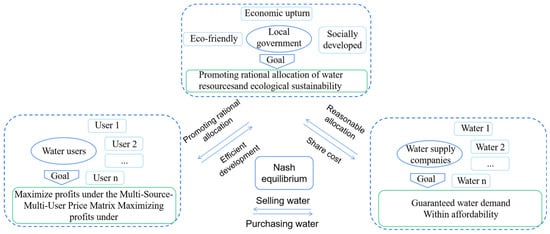
Figure 1.
The game relationship between multiple agents.
2.2. Multi-Party Game Model of Water Price Based on Equilibrium Theory of Water Price
2.2.1. Game Participant
The game of water prices involves the interests of the government, water supply enterprises, and water users; all parties influence and restrict each other in the game of water price regulation [39]. Water supply companies aim to balance high prices for investment recovery with users’ desire for affordable, reliable water services. The government has the responsibility to set water prices and supervise water supply enterprises and needs to take into account the reasonable demands of water users and obtain reasonable price relations between different users with different water sources to obtain more social, environmental, and ecological benefits.
2.2.2. Game Strategy Set
Game strategy refers to the methods and paths that each player in the game can choose when making decisions. During the equilibrium water price game, the strategies are the proposals made by the players to increase or decrease the water price in different rounds.
The local government’s strategy, called Strategy A, involves a choice between two boundary options promoting conventional water and promoting reclaimed water. Water supply price cost sharing is actually to guarantee and improve people’s livelihoods. Therefore, the cost-sharing limit is set based on the economic development report of the local government, with the upper limit being the proportion of expenditure on livelihood improvement and the lower limit being half of that expenditure or the proportion set by the government. The strategy of the water supply firm is called Strategy B and involves choosing the game strategy with minimal or no profit. The upper limit is determined by the “return on equity capital” mentioned in the Regulation on the Price Management of Urban Water Supply, which is the national average 10-year bond yield plus no more than 4%, and the lower limit is to guarantee no losses. The water user’s strategy, referred to as Strategy C, involves total water expenditure as a proportion of disposable income. The upper limit of water fee payment refers to the Research Report on Urban Water Shortage; the upper limit is the proportion of water fee expenditure to residents’ disposable income before the price adjustment, and the lower limit is the proportion of water fee expenditure to residents’ disposable income. The framework of the game is shown in Figure 2.
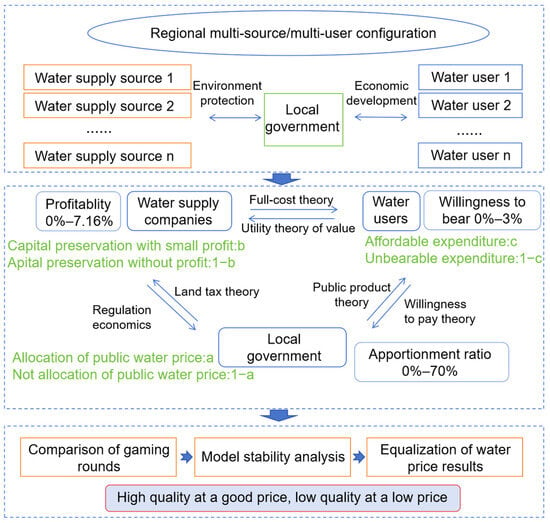
Figure 2.
The framework of water price game model.
Parties argue to raise or lower prices within their respective strategic space, depending on their willingness and satisfaction with the benefits. The boundary conditions of each party’s strategy interval are shown in Figure 3.
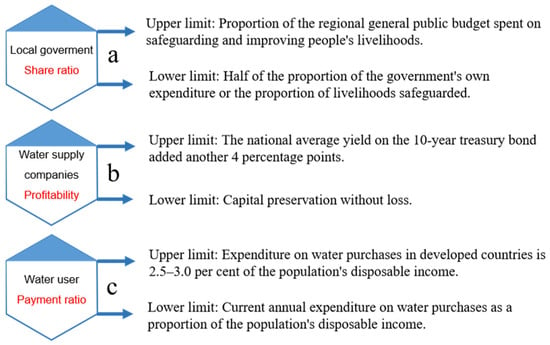
Figure 3.
Interval and boundary conditions of local government strategy (a), water utility strategy (b), and water user strategy (c).
2.2.3. Game Model Solution
Participant Information
The optimal allocation of high-quality water resources is expected to pursue the high-quality, coordinated development of the economy, society, and environment. Expected income refers to the social income, environmental income, and economic income finally obtained by the local government, water supply enterprises, and water users after adjusting the water price and price comparison relationship through the game process under their respective constraints. The benefits of local governments include two aspects: social and environmental benefits. Social benefits refer to the fact that the government promotes the rational allocation of water resources with multiple sources and multiple users through the pursuit of balanced water pricing, realizes the harmonious development of water and society, and alleviates the uneven distribution of water resources. The competition between supply and demand is one of the primary purposes of the implementation of balanced water pricing. Therefore, the social benefits are reflected by the surplus of the available water P minus the total water C allocated to different users in the game process. Environmental benefits refer to the improvement of water resources on the ecological environment. Non-conventional water sources such as recycled water can effectively replace conventional water and reduce sewage and wastewater discharge. Hence, it is manifested by the volume of water resource contaminants in the locality, specifically the quantity of effluent release U subtracted by the quantity of effluent and water purification A and the quantity of ecological contamination E. The economic benefits of water supply enterprises refer to the benefits brought by regulating the water price mechanism in allocating multiple water sources. It comprises construction technology cost N, maintenance and operation cost M, water sales revenue R, and reclaimed water subsidy fund O. Water users also factor in the financial advantages, and the numerical method includes the immediate gains H from using traditional water for various user groups and the cost savings K from total water usage minus the specific disposal cost B that must be covered. The corresponding benefits under each game strategy are presented in matrix form in Table 1.

Table 1.
Tripartite strategies and expected returns.
The government chooses the expected income of the strategy of “sharing public water price” and “not sharing public water price”, expressed by Ua1 and Ua2, respectively:
Ua1 = bcU1,1 + (1 − b)(1 − c)U2,2 + c(1 − b)U2,1 + b(1 − c)U1,2
Ua2 = bcU3,1 + b(1 − c)U3,2 + (1 − b)(1− c)U4,2
The average government expectation is
The expected returns of water supply enterprises choose the strategies of “minimal profit” and “no profit”, expressed by Ub1 and Ub2, respectively:
Ub1 = acU1,3 + a(1 − c)U1,4 + c(1 − a)U3,3 + (1 − a)(1 − b)U3,4
Ub2 = 0
Consumers choose the expected benefits of the “affordable spending” and “unbearable spending” strategies, using Uc1 and Uc2, respectively:
Uc1 = ab U1,5 + (1 − a)b U3,5
Uc2 = ab U1,6 + a(1 − b)U2,6 + b(1 − a)U3,6 + (1 − a)(1 − b)U4,6
The goal of the game is to achieve the three equilibrium goals of the rationality of local government allocation, the profitability of water supply enterprises, and the rationality of water users’ payment, and pursue the maximum economic benefits and the best social benefits:
Game Constraint
In the process of realizing the unified allocation of recycled water and making full use of various water sources, the game price can recognize the compensation cost and reasonable profit of each water supply enterprise, and the water fee expenditure should not exceed r of the disposable income percentage of each user, which requires the following constraints:
where Qi,j is the water consumption of water users of category i water source and category j; Wj is the minimum water requirement of the type j water user; Ci is the total process cost water price for the type i water source; and Mj is the disposable income of category j users.
Game Solving
For the above model, LINGO 18.0 ×64 software programming was used to solve it. The model-solving process box is shown in the following Figure 4.
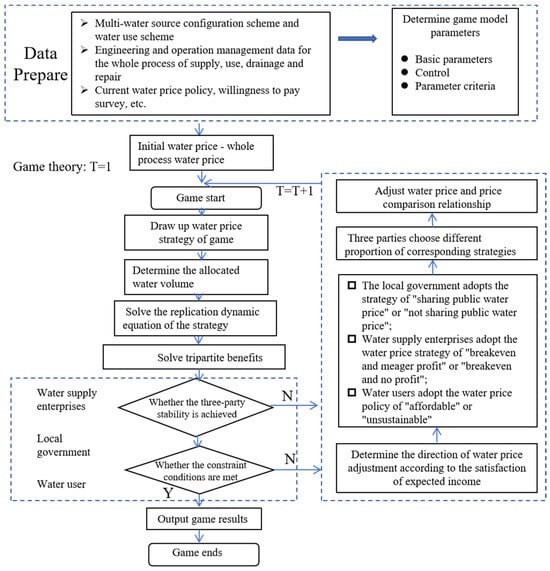
Figure 4.
Block diagram of model-solving flow.
3. Case Study
3.1. Study Area
Pinghu City is located on the East China Sea coast, at the Hangjiahu Plain’s eastern end in northeastern Zhejiang Province and the southern wing of the Yangtze River Delta. The total annual average water resources are 283 million m3. The current water supply sources in Pinghu City include water from outside the domain, river network water, unconventional water, etc., and the water users are generalized into three categories: residential users, non-residential users, and special water users. The limited water resources and increased water demand are increasingly restricting the sustainable development of Pinghu City. The location of the research area is shown in Figure 5.
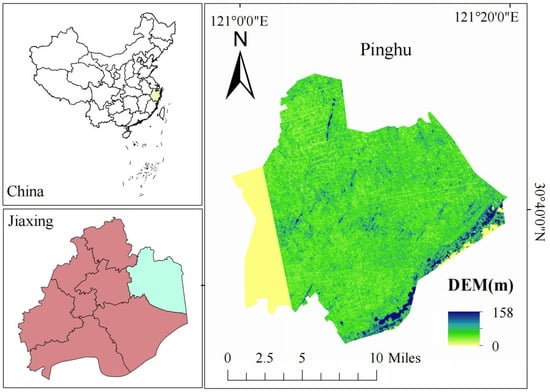
Figure 5.
The study area.
The current industrial water reuse rate in Pinghu City is low, and living water saving needs to be improved. The current industrial water reuse rate in Pinghu City is 75%, lower than the average level of Jiaxing City and Zhejiang Province. The industrial and domestic water consumption of Pinghu City is 88.13 million m3, accounting for 86.8% of the assessment target in 2020, which is close to the red line. Moreover, just 60% of the entire area has implemented varied water distribution, and a distinct water supply framework has not been established.
3.2. Data Source and Processing
Our data sources are the Zhejiang Water Supply Yearbook 2021, Jiaxing Water Conservation Action Implementation Plan, Statistical Bulletin of National Economic and Social Development of Pinghu City 2021, Report on the Master Plan for Water Resources Conservation, Protection and Utilization of Pinghu City, Measures for Urban Water Supply Price Management, National Urban Water Price Network, and other relevant information on Pinghu City. The resulting water use scheme and the full-cost water price in the study area are shown in Table 2 and Table 3.

Table 2.
Structure of water supply and consumption in Pinghu City.

Table 3.
Analysis results and values of water price components after external internalization.
3.3. Process of Game
In Pinghu City, based on the government’s above-mentioned apportion behavior, water supply enterprise income behavior, and water user expenditure behavior, the tripartite strategy is constructed, and the corresponding income matrix is listed in Table 1. The following parameters are involved in the multi-water source and multi-user water resource configuration in Pinghu City. The explanation and calculation formulas have been mentioned in Table 4.

Table 4.
Meaning of parameters and value method of Pinghu example model.
4. Results and Discussion
4.1. Results of Equilibrium Water Price Game in Yiwu City
In the game process, the initial strategy is determined by using the relationship between the water price and the multi-source water price of the entire process in Pinghu City as the reference and then selecting the water use selection plan for various water users. Secondly, based on the water price strategy and water use plan, the allocation of water volume and the expected revenue of the three parties for each game round are solved, and it is judged whether the strategy meets the constraints [40]. At the same time, the economic benefits of the government, water supply enterprises, and water users are calculated separately. It is judged whether the economic benefits are maximized and whether the water volume meets the demand. If not, the local government, water supply enterprises, and water users adjust their strategies according to their respective proportions, the water supply enterprises according to the profit rate, and water users according to their ability to bear costs to reshape the price relationship by adjusting the water price. The game process reveals the results of each round’s calculations, outputting the equilibrium water price when the system’s economic benefits peak and meet the three parties’ constraints. To display the results of the three-party game model more directly, a price line chart was drawn to represent the water price and water resource allocation scheme in the game process, as shown in Figure 6.
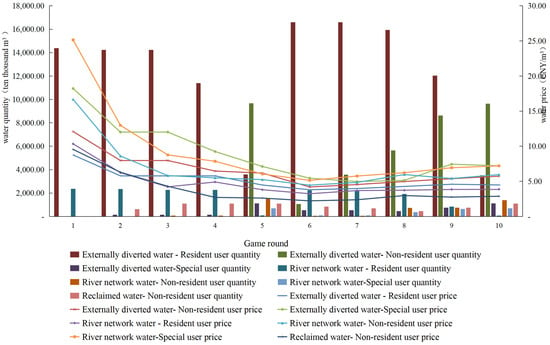
Figure 6.
Water price change during the six-round game process.
The application of the game method in Pinghu City has achieved the expected configuration effect of “high quality and high price, each to its best use”; that is, as shown in Figure 7, according to the type of water source, the path of external water diversion–river network water–reclaimed water and the price gradient of “quality–price match” has been formed. In terms of water use type, the price gradient of resident user–non-resident user–special user is formed according to the paying ability. At this time, the optimal water resource allocation is shown in the pie chart, and the external water diversion allocation is the most, giving full play to the water supply capacity of unconventional water in the city [41]. Residential users prefer high-quality external diversion water, and non-resident users prefer affordable river network water, so all kinds of water sources can be used to achieve efficient regulation and control of regional water resources.

Figure 7.
Water resource allocation situation corresponding to optimal game price.
According to the game criteria as mentioned above, the reasonable price comparison relationship of multi-water sources based on the whole process in Pinghu City appeared in the fifth round, and the final water price results are shown in Table 5 below.

Table 5.
Analysis results of the reasonable price comparison relationship of multiple water sources in Pinghu City based on the whole-process water price.
The multi-source/multi-user water-pricing system balances the supply and demand of water from different sources and the market flow through the coordination of water pricing and uses the price lever in economics to manage water use so as to improve the comprehensive utilization rate of water resources and achieve the purpose of water saving. In this paper, Pinghu City in Zhejiang Province is selected as a typical area for the implementation of differentiated water supply, and the constructed game model is used to study the multi-source and multi-user water-pricing system in this area shown in Table 5. By comparing the water-pricing results obtained by the game model with the current demand-side water price in Pinghu City, which has been mentioned in Table 6, it has been revealed that the current water-pricing policy in Pinghu City only considers different users from the demand side but does not distinguish various water sources from the supply side. From the demand side, the water price obtained by the game model is higher than the current water-pricing policy. In the realm of residential water consumption, a tiered pricing strategy is applied, with each tier priced below the full-cost water rate. The water price after the game distinguishes high-quality water from general water so that river water and reclaimed water have more price advantages on the demand side. For non-residential water use, the game price calculation result is also higher than the current water price, but the range is slightly larger than that of residential water use, reflecting the principle of fairness in resource price setting. The price of reclaimed water is lower than that of the other two types of water sources. For special water use, the price calculation result after the game is higher than that of other water users, which reflects the price fairness among users. Therefore, the equilibrium water price result solved by the game model provides specific profit space for each water source enterprise on the supply side by reshaping the price comparison relationship on the demand side.

Table 6.
Current water price policy of Pinghu City.
4.2. Regional Game Participant Benefit System
Through a series of adjustments and evolution, a comprehensive model and method have been developed to establish an optimal water price strategy that meets the needs of local governments, water supply enterprises, and water users, ultimately resulting in dynamic equations for water price changes and stakeholder expectations. The results from Table 4 are used in Formulas (3)–(9) to generate a line chart showing the expected income changes in a multi-water/multi-user game setup in Pinghu City across various rounds, as shown in Figure 8.
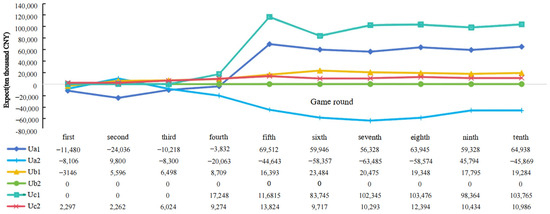
Figure 8.
Tripartite expected changes in the six-round game process.
As seen from Figure 9, with the increase in the government allocation ratio, the whole game process leads to a gradual decrease in the water price trend and an increase in the water allocation. Rational allocation of water resources can increase participants’ returns [42]. Regarding water users’ total payment, there was a corresponding positive correlation between the water supply, namely the “more water” configuration, and the user payment, but in terms of their ratio, because of the game, there was greater efficiency in the user’s water spending, which can allow them to better meet their own water demand and enable optimal cost performance. In this study, the total amount paid by water users at the end of the game is RMB 994.91 million, which is higher than the revenue from water sales under the current water-pricing policy in Pinghu City of RMB 586.25 million but still lower than the upper limit of water expenditure of RMB 144.5 million. A two-way relationship between water supply enterprises and water users was achieved under the government’s share. Therefore, after the game, the water price and resource allocation scenario reduced the total payment amount of water users to the current level. At the same time, the income of water supply enterprises also increased, achieving the government’s distribution plan, revenue approach for water supply businesses, and pricing strategy for water while maintaining a balance according to the rational allocation theory of water resources. This ensures a harmonious relationship among the government, water suppliers, and water users in terms of expenses and profits, supporting the sustainable growth and utilization of water resources. It also establishes a justifiable comparison link between users based on water characteristics. The findings of the Pinghu City research exhibit that a rational cost proportion founded on numerous water origins without escalating the load on the authorities (i.e., the distribution proportion remains unaltered) efficiently encourages the utilization of reused water and attains harmonious advancement of water safety and water environmental ecological protection [43].
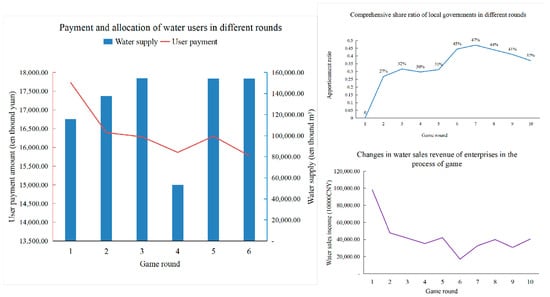
Figure 9.
Change in the tripartite payment function in the six-round game process.
4.3. Game Rationality Analysis
The ideal water price, as seen by local government, aligns with a water resource configuration quantity of 196,980 thousand m3 in Yiwu City, utilizing multiple water sources and a multi-user water supply system, including 23,200 thousand m3 of recycled water with a 12% configuration rate to maximally utilize the existing recycled water processing capacity. Secondly, the total tax revenue of Yiwu City in 2020 was CNY 498.2407 million, and the total amount of distribution under the optimal pricing situation was CNY 338.04 million, accounting for 0.68%, which will not bring financial pressure to the local government. From the perspective of water suppliers, the previous water supplier’s revenue was CNY 234.22 million, and the optimal pricing situation benefits the water supplier by CNY 239.25 million, with a slight increase of 3.6%. The current water price payment amount is CNY 408.82 million, and the total amount paid by water users after the game is CNY 856.25 million. Although it has increased tenfold, it still does not exceed 3% of the maximum water expenditure that can be borne by the annual disposable income, which is CNY 88,425 million.
The current water price of diversion water, river water, and reclaimed water outside Pinghu City shows that the better the water quality, the lower the full-cost water price, which is contrary to the price law of the current water price and the acceptance angle of the “quality–price match” of users, resulting in the shortage of high-quality water and the phenomenon of low-quality water such as river water and reclaimed water. It is also not conducive to the sustainable development of low-quality water and the promotion of differentiated water supply. The equilibrium water price determined by the game model aligns with both water supply costs and user preferences, as well as adheres to the Water Law’s principle of high quality and high price, promoting efficient allocation of regional water resources, alleviating supply–demand conflicts, and preventing harm to water ecosystems. In summary, the current water price is challenging to ensure the sustainable development of all water supply enterprises and is not conducive to the rational allocation of water resources. The formulation of water prices needs to organically unify the multi-water source on the supply side and multi-users on the demand side and establish a multi-water source and multi-user balanced water price system with scientific price comparison. In order to ensure that the water supply enterprises can guarantee the capital and small profits, through the price lever, it is necessary to promote the use of unconventional water and the rational allocation of water resources.
After the local government reasonably participated in the water price, both the water supplier and the water user achieved a win–win situation. The concept of water pricing aims to align with the government’s distribution strategy, the water supplier’s revenue goals, and the payment strategy of water users, ensuring a balance between cost coverage and reasonable profits within the framework of resource allocation. It can meet the sustainable development and utilization of water resources and form a reasonable relationship between multiple water sources, attributes, and users. The research results of Yiwu City show that without increasing the government’s burden (i.e., the distribution ratio remains unchanged), based on the reasonable pricing relationship of multiple water sources, effective promotion of wastewater utilization is achieved, and both water security and water ecological environment protection are achieved.
4.4. Strengths, Limitations, and Future Work
This study broadens the existing research perspective of water price setting. It provides a complete three-party multi-water/multi-user equilibrium water price setting game model, enriching the water resource economics theory. The equilibrium water price determined in this study is more equitable and justifiable than the conventional approach, gaining acceptance from both water suppliers and consumers and facilitating the allocation of water resources. The method can also be applied to determine the equilibrium water price in different areas, aiding the government in adjusting prices and managing stakeholder interactions, offering theoretical and practical value. The study of the influence of the game method on water price mainly focuses on the game between water supply enterprises and the decision game between water supply enterprises and water users, so the analysis of water price negotiation between government control strategy and water supply enterprises remains to be studied. Due to the limited sample data, this paper only selected Pinghu City as the research area. In future work, more data will be collected to explain larger cities’ equilibrium water price theory. In addition, this study did not consider the elastic change in water demand under price changes, so the specific classification of multi-water source/multi-user systems and the optimization plan of water structures need to be further studied.
5. Conclusions
In this research, a tripartite payoff game model was established using Pinghu City, Zhejiang Province, as a case study involving local government, water supply enterprises, and water users, and multiple rounds of game analysis were conducted to observe changes in expected returns, leading to the summarization of our main conclusions:
- (1)
- The optimal water price strategy can be broken down as follows: externally diverted water for residential users is 4.48 CNY/m3, externally diverted water for non-residential users is 6.18 CNY/m3, externally diverted water for special users is 7.12 CNY/m3, river network water for residential users is 3.81 CNY/m3, river network water for non-resident users is 5.25 CNY/m3, river network water for special users is 6.05 CNY/m3, and reclaimed water for non-residential users is 2.62 CNY/m3.
- (2)
- The local government share price is not higher than before the inclusion of recycled water allocation. The annual revenue of water supply enterprises increased from CNY 586.25 million to CNY 994.91 million, which is still far below the cap of CNY 144.5 million of water purchase expenditure in Pinghu City. The game process achieves a win–win situation for both supply and demand, indicating that the method can effectively balance the equilibrium, rights and objectives, multi-entity costs, and water prices in the Pinghu process.
- (3)
- The equilibrium water price game model with local government, water-using enterprises, and water users as the main body constructed in the study expands the research on water price setting that generally only focuses on both supply and demand sides. This method considers collaborative competition among multiple entities, mutual complementarity among multiple water sources, and payment balance among multiple users, avoiding the imbalance problem caused by traditional verification and approval mechanisms. It provides a new method for the multi-water source and multi-user water price setting in China’s future water network construction, making water price setting more systematic.
- (4)
- The game model of this paper is constructed in a complete information structure, but in reality, local governments, water supply enterprises, and water users often have information asymmetry. However, the fundamental principles outlined in this paper can serve as a solid basis for future research aimed at developing a game model that closely reflects real-world scenarios, indicating a promising avenue for further investigation.
Author Contributions
S.W. developed the original idea and contributed to the research design for the study. C.N. and X.G. have given some revision opinions for the article. L.Q. and S.Y. were responsible for data collection and charting and provided some guidance for the writing of the article. C.H., S.-e.-h.S. and S.L. provided guidance and suggestions for improvement. All authors have read and agreed to the published version of the manuscript.
Funding
This work was supported by the National key research and development project (2019YFC0408800) and National Natural Science Foundation of China (U2243219).
Data Availability Statement
The authors do not have permission to share data.
Conflicts of Interest
The authors declare that they have no known competing financial interests or personal relationships that could have appeared to influence the work reported in this paper.
References
- Gao, Q.; Zhang, Q.; Zeng, J.; Yin, Z.; Liu, J.; Liu, G. Macroinvertebrate community structure, pollution tolerance, diversity and feeding functional groups in polluted urban rivers under different black and odorous levels. Ecol. Indic. 2023, 156, 111148. [Google Scholar] [CrossRef]
- Wang, N.; Yan, H.; Long, K.; Wang, Y.; Li, S. Impact of greenspaces and water bodies on hydrological processes in an urbanizing area: A case study of the Liuxi River Basin in the Pearl River Delta, China. Ecol. Indic. 2023, 156, 111083. [Google Scholar] [CrossRef]
- Bruno, E.M.; Jessoe, K. Using Price Elasticities of Water Demand to Inform Policy. Annu. Rev. Resour. Econ. 2021, 13, 427–441. [Google Scholar] [CrossRef]
- Si, Y.; Li, Y. Research on urban water pricing method based on Ramsey model. J. Harbin Commer. Univ. (Soc. Sci. Ed.) 2010, 4, 107–110. [Google Scholar]
- Robak, A.; Lefort, M.; Soederberg, M. How water consumers form preferences for price guarantees: The roles of historic price variability, trust and risk appetite. Urban Water J. 2021, 18, 617–630. [Google Scholar] [CrossRef]
- Luckmann, J.; Flaig, D.; Grethe, H.; Siddig, K. Modelling Sectorally Differentiated Water Prices—Water Preservation and Welfare Gains Through Price Reform? Water Resour. Manag. 2016, 30, 2327–2342. [Google Scholar] [CrossRef]
- Wu, L.; Tian, J.; Zhou, H. Use of the Cooperative Game Model for Water Rights Trade. J. Hydropower 2012, 31, 53–58. [Google Scholar]
- Rogers, P.; De Silva, R.; Bhatia, R. Water is an economic good: How to use prices to promote equity, efficiency, and sustainability. Water Policy 2002, 4, 1–17. [Google Scholar] [CrossRef]
- Li, X.; Engel, B.A.; Duan, P.; Sun, S.; Wang, Y. Developing an agricultural water pricing model considering both physical and virtual water: A case study of an irrigation district in China. J. Clean. Prod. 2022, 368, 133043. [Google Scholar] [CrossRef]
- Fu, T.; Zhang, L.; Chang, M. Target Structure, and Principle for Pricing of Water. China Water Wastewater 2006, 22, 15–18. [Google Scholar]
- Wu, Z.; Li, F.; Chen, H.; Zhang, X.; Xu, D.; Fu, S. Research on comprehensive water price of multiple sources and links based on optimal allocation. China Rural Water Resour. Hydropower 2021, 9, 76–79. [Google Scholar]
- Xu, D.; Liu, X. Build a reasonable water price system to promote the construction of ecological civilization—Deepen the reform of water price and build a leading area of ecological civilization in Guizhou. Price Theory Pract. 2022, 6, 5–6, 17. [Google Scholar]
- Hou, S. Assessment of Water Saving Level in National Districts Based on Water Use Process. Master’s Thesis, Zhengzhou University, Zhengzhou, China, 2021. [Google Scholar]
- An, F. Study on the Pricing of Urban Tap Water in China. Ph.D. Thesis, Shandong University, Jinan, China, 2007. [Google Scholar]
- Yang, L.; Lin, Y.; Zhu, J.; Yang, K. Dynamic coupling coordination and spatial–temporal analysis of digital economy and carbon environment governance from provinces in China. Ecol. Indic. 2023, 156, 111091. [Google Scholar] [CrossRef]
- Iglesias, E.; Blanco, M. New directions in water resources management: The role of water pricing policies. Water Resour. Res. 2008, 44–50, 44–50. [Google Scholar] [CrossRef]
- Li, G. Research on Efficient Utilization of Water Resources and Allocation of Water Rights in Ningxia. Ph.D. Thesis, Xi’an University of Technology, Xi’an, China, 2021. [Google Scholar]
- MacDonald, D.H.; Morrison, M.D.; Barnes, M.B. Willingness to Pay and Willingness to Accept Compensation for Changes in Urban Water Customer Service Standards. Water Resour. Manag. 2010, 24, 3145–3158. [Google Scholar] [CrossRef]
- Long, J.; Tang, M.; Zhao, W.J.; Zhu, L.; Gong, Z.N.; Su, Y. Appraisal of Beijing wetlands water purification value. Presented at the 4th International Conference on Bioinformatics and Biomedical Engineering (iCBBE), Chengdu, China, 18–20 June 2010. [Google Scholar]
- Liao, H. Yunnan water pricing model based on game theory. Water-Sav. Irrig. 2010, 10, 78–80. [Google Scholar]
- Jiang, W.; Zhuang, W.; Wen, C.; Pang, Y.; Chao, J. Calculation of ecological water replenishment in small coastal watersheds based on environmental capacity constraints: A case study of eastern Xiamen, China. Ecol. Indic. 2023, 155, 111034. [Google Scholar] [CrossRef]
- Wang, X.; Tan, X.; Chen, Y. Research on the construction of water price full cost pricing model. Hydropower Energy Sci. 2011, 29, 109–112. [Google Scholar]
- Guan, X.; Du, Q.; Zhang, W.; Wang, B. Study on the Pricing of Water Rights Transaction between Irrigation Water Users Based on Cooperative Game in China. Water 2021, 13, 1672. [Google Scholar] [CrossRef]
- Lu, L. The game between water price reform and water-saving technology promotion. Water Econ. 2011, 29, 31–33,37,72. [Google Scholar]
- Zhang, P. Study on the Willingness to Pay and Receive Ecological Compensation of Residents in Alar City, the First Division. Master’s Thesis, Tarim University, Alar, China, 2017. [Google Scholar]
- Zhang, B. Research on market linkage pricing and allocation mechanism of water resources for the Middle Route of the South-to-North Water Transfer Project. Yellow River 2019, 45, 88–92, 114. [Google Scholar]
- Garcia-Lopez, M.; Montano, B.; Melgarejo, J. Water Pricing Policy as Tool to Induce Efficiency in Water Resources Management. Int. J. Environ. Res. Public Health 2020, 17, 3534. [Google Scholar] [CrossRef] [PubMed]
- Du, R.; Chen, H.; Cui, G. Case study on elastic water price and bearing capacity of water users. J. Hohai Univ. Nat. Sci. 2003, 31, 475–478. [Google Scholar]
- Yang, L.; Xia, L.; Hou, L.; Li, D. Application of Dynamic Pricing Method in Water Price Calculation of Wujiaqu City. Water Resour. Power 2013, 31, 171–175. [Google Scholar]
- Qi, G. Living water price of city & town residents and its structure analysis. J. Gansu Agric. Univ. 2002, 37, 221–225. [Google Scholar]
- Ma, T.; Zhang, X.; Fan, Y.; Chen, M. Decision-making model of impact of water price for urban water-consumption. J. Northeast Agric. Univ. 2013, 44, 82–87. [Google Scholar]
- Yin, Z.; Liu, Y.; Tang, L.; Zhou, W.; Pan, Y. Spatial-temporal evolution of agricultural land utilization benefits and tradeoffs/synergies in the Beijing-Tianjin-Hebei region. Ecol. Indic. 2023, 156, 111110. [Google Scholar] [CrossRef]
- Kogan, K.; Tsadikovich, D.; Avinadav, T. Water scarcity and welfare: Regulated public-private supply chain versus spot-market competition. IISE Trans. 2022, 54, 757–769. [Google Scholar]
- Wu, X.; Zhang, Y. Coupling analysis of ecological environment evaluation and urbanization using projection pursuit model in Xi’an, China. Ecol. Indic. 2023, 156, 111078. [Google Scholar] [CrossRef]
- Qin, C.; Gan, H.; Zhang, X.; Jia, L. Study on water pricing method and practice Ⅱ. Discussion on water price of the Haihe Basin. J. Hydraul. Eng. 2012, 43, 429–436. [Google Scholar]
- Sui, G.; Wang, H.; Cai, S.; Cui, W. Coupling coordination analysis of resources, economy, and ecology in the Yellow River Basin. Ecol. Indic. 2023, 156, 111133. [Google Scholar] [CrossRef]
- Yuan, M.; Xiao, Y.; Yang, Y.; Liu, C. Coupling coordination analysis of the economy-ecology-society complex systems in China’s Wenchuan earthquake disaster area. Ecol. Indic. 2023, 156, 111145. [Google Scholar] [CrossRef]
- Zhang, Y.; He, N.; Yang, S.; Wang, L.; Yuan, S. Third party supervision strategy of water ecological PPP project based on evolutionary game. Water Resour. Prot. 2021, 37, 166–172. [Google Scholar]
- Suzuki, H.; Tsuji, M.; Hirabayashi, R. Journal of the Operations Research Society of Japan. Water Salesm. Probl. 1987, 30, 472–492. [Google Scholar]
- Jin, R.; Zhang, J.; Zuo, Q. Research Progress and Ideas of Game Theory in Human-Water Relationship. South-North Water Transf. Water Sci. Technol. 2013, 11, 138–143. [Google Scholar]
- Xu, L.; Tu, Z.; Yang, J.; Zhang, C.; Chen, X.; Gu, Y.; Yu, G. A water pricing model for urban areas based on water accessibility. J. Environ. Manag. 2023, 327, 116880. [Google Scholar] [CrossRef]
- Vahedizade, S.; Emamjomehzadeh, O.; Kerachian, R.; Forouhar, L. A real-time market-based framework for basin-wide surface water pricing and allocation considering the available water uncertainty. J. Environ. Manag. 2023, 345, 118767. [Google Scholar] [CrossRef]
- Mao, C.; Zuo, Q. Study on Game Mechanism of Human-water Relationship and Its Calculating Method. Water Resour. Power 2013, 31, 155–158. [Google Scholar]
Disclaimer/Publisher’s Note: The statements, opinions and data contained in all publications are solely those of the individual author(s) and contributor(s) and not of MDPI and/or the editor(s). MDPI and/or the editor(s) disclaim responsibility for any injury to people or property resulting from any ideas, methods, instructions or products referred to in the content. |
© 2024 by the authors. Licensee MDPI, Basel, Switzerland. This article is an open access article distributed under the terms and conditions of the Creative Commons Attribution (CC BY) license (https://creativecommons.org/licenses/by/4.0/).